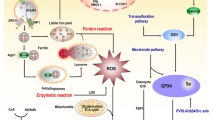Abstract
Magnolol inhibited proliferation of human malignant melanoma A375-S2 cells. The drug induced oligonucleosomal fragmentation of DNA in A375-S2 cells and increased caspase-3, 8, 9 activities followed by the degradation of caspase-3 substrates, inhibitor of caspase dependent DNase (ICAD) and poly-(ADP-ribose) polymerase (PARP). Pan-caspase inhibitor (z-VADfmk), caspase-3 inhibitor (z-DEVD-fmk), capase-8 inhibitor (z-IETD-fmk), caspase-9 inhibitor (z-LEHD-fmk) and caspase-10 inhibitor (z-AEVD-fmk) inhibited magnolol-induced A375-S2 cell apoptosis. The level of anti-apoptotic mitochondrial protein Bcl-2 was up-regulated while the level of pro-apoptotic protein Bax was down-regulated. Taken together, our results indicate that magnolol induces apoptosis by activation of both mitochondrial and death receptor pathways in A375-S2 cells.
Similar content being viewed by others
References
Adams, J. M. and Cory, S., The Bcl-2 Protein Family: Arbiters of cell survival. Science, 281, 1322–1326 (1998).
Budihardjo, I., Oliver, H., Lutter, M., Luo, X., and Wang, X., Biochemical pathways of caspase activation during apoptosis. Annu. Rev. Cell Dev. Biol., 15, 269–290 (1999).
Cheng, E. H., Wei, M. C., Weiler, S., Flavell, R. A., Mak, T. W., Lindsten, T., and Korsmeyer, S. J., Bcl-2, Bcl-X(L) sequester BH3 domain-only molecules preventing BAXand BAK-mediated mitochondrial apoptosis. Mol. Cell, 8, 705–711 (2001).
Enari, M., Sakahira, H., Yokoyama, H., Okawa, K., Iwamatsu, A., and Nagata, S. A., Caspase-activated DNase that degrades DNA during apoptosis and its inhibitor ICAD. Nature, 391, 43–50 (1998).
Ferreira, C. G., Epping, M., Kruyt, F. A. E., and Giaccone, G., Apoptosis: Target of cancer therapy. Clin. Cancer Res., 8, 2024–2034 (2002).
Huang, D. C. and Strasser, A., BH3-Only proteins-essential initiators of apoptotic cell death. Cell, 103, 839–842 (2000).
Hunt, A. and Evan, G., Till death us do part. Science, 293, 1784–1785 (2001).
Ikai, T., Akao, Y., Nakagawa, Y., Ohguchi, K., Sakai, Y., and Nozawa, Y., Magnolol-induced apoptosis is mediated via the intrinsic pathway with release of AIF from mitochondria in U937 cells. Biol. Pharm. Bull., 29, 2498–2501 (2006).
Kitamura, Y., Miyamura, A., Takata, K., Inden, M., Tsuchiya, D., Nakamura, K., and Taniguchi, T., Possible involvement of both endoplasmic reticulumand mitochondria-dependent pathways in hapsigargin-induced apoptosis in human neuroblastoma SH-SY5Y cells. J. Pharmacol. Sci., 92, 228–236 (2003).
Korsmeyer, S. J., Wei, M. C., Saito, M., Weiler, S., Oh, K. J., and Schlesinger, P. H., Pro-apoptotic cascade activates BID, which oligomerizes BAK or BAX into pores that result in the release of cytochrome c. Cell Death Differ., 7, 1166–1173 (2000).
Lee, D. H., Szczepanski, M. J., and Lee. Y. J., Magnolol induces apoptosis via inhibiting the EGFR/PI3K/Akt signaling pathway in human prostate cancer cells. J. Cell. Biochem., 106, 1113–1122 (2009).
Li, H. B., Yi, X., Gao, J. M., Ying, X. X., Guan, H. Q., and Li, J. C., Magnolol-induced H460 cells death via autophagy but not apoptosis. Arch. Pharm. Res., 30, 1566–1574 (2007).
Suzuki, K., Hino, M., Kutsuna, H., Hato, F., Sakamoto, C., Takahashi, T., Tatsumi, N., and Kitagawa, S., Selective activation of p38 Mitogen-activated protein kinase cascade in human neutrophils stimulated by IL-1β. J. Immunol., 167, 5940–5947 (2001).
Takano, F., Tanaka, T., Tsukamoto, W., Yahagi, N., and Fushiya, S., Isolation of (+)-catenin and (−)-epicatenin from Actinidia arguta as bone marrow cell proliferation promoting compounds. Planta Med., 69, 321–326 (2003).
Thornberry, N. A. and Lazebnik, Y., Caspases: Enemies within. Science, 281, 1312–1316 (1998).
Zhang, Y., Zhang, Q. H., Wu, L. J., Tashiro, S., Onodera, S., and Ikejima, T., Atypical apoptosis in L929 cells induced by evodiame isolated from Evodia Rutaecarpa. J. Asian Nat. Prod. Res., 6, 19–27 (2004).
Zhong, W. B., Wang, C. Y., Ho, K. J., Lu, F. J., Chang, T. C., and Lee, W. S., Magnolol induces apoptosis in human leukemia cells via cytochrome c release and caspase activation. Anticancer Drugs, 14, 211–217 (2003).
Author information
Authors and Affiliations
Corresponding author
Rights and permissions
About this article
Cite this article
You, Q., Li, M. & Jiao, G. Magnolol induces apoptosis via activation of both mitochondrial and death receptor pathways in A375-S2 cells. Arch. Pharm. Res. 32, 1789–1794 (2009). https://doi.org/10.1007/s12272-009-2218-6
Received:
Revised:
Accepted:
Published:
Issue Date:
DOI: https://doi.org/10.1007/s12272-009-2218-6




